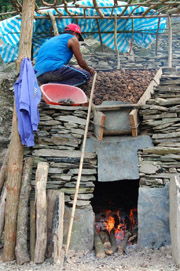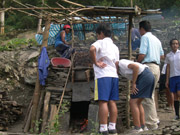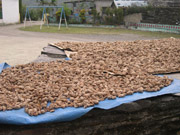The major diet of Paiwan Tribe include sweet-potatoes, yams and dried products made from them that can be preserved and fights hunger. Rice is considered to be an important food during celebrations and many of Paiwan’s delicacies, such as chinafu, rice wine, kinboler are all based on rice. Plants growing in the wild can be obtained and made into delicious foods at anytime. These gifts from the earth can be transformed into tasty foods by the hands of Paiwan tribesmen.

The Paiwan tribesmen lived on the mountains and their food and tools were also obtained from nature. Since the lands of Paiwan are less rich they mainly grew sweet-potatoes, yams and rice and supplemented their diet with wild plants such as amaranth and cabbage to make unique dishes. Their tools, such as mats and baskets, were often woven from alpinia and bamboo species.

-
Sweet Potatoes: There are many species and generally categorized into edible, feed, starch and edible-leaf species. The harvested potatoes were mainly eaten after being boiled, or the boiled potatoes may be pounded into a mash and wrapped in boiled Trichodesma leaves to make chinafu.
-
Yams: Seeds are planted in March each year and harvested in October. The harvested yams are peeled and seasoned with salt for eating, else they are sun-dried into dried yams, and although this is not as “fancy” as rice it is an irreplaceable food during droughts. Also, hunters often carry dried-yams and peanuts for meals, since it delays hunger by being hard to digest.
-
Rice: Seeds are planted in May each year and harvested in August. The harvested rice are dried in the sun and beaten with sticks to separate the husks from the rice – the husks are then sieved out. The boiled rice are pounded with sticks and wrapped in Trichodesma leaves as an offering to god, and can only be eaten after being offered.
-
Betel nuts: Although it is not edible they cannot be left out. Records of betel-nut chewing by aborigines date back to literature from the Chin and Japanese Occupation periods. Aborigines in Jiayi also carry this practice. Before chewing the betel nut it is first wrapped in betel leaf smeared with lime. Early practices of betel nut chewing were for teeth darkening as it was considered a sign of beauty, however it became so common that people depended on it for energy and not vanity.
-
Alpinia species: It is not used for eating but still formed a needed part of daily-living. They are perennial plants that grow to a height of between 1 to 3m. The leaves are needle-shaped and its flowers hang in rows. Its fruits are ball-shaped with surface ridges, and its color ranges from bright green of immature fruits to a mature bright red, a gorgeous color. Alpinia species are distributed across the lower sea-level mountain ranges in the tropics and is a very common plant. It has medicinal, food and entertaining values. The Alpinia species carry deep cultural meanings: mats are made from dried leaves, which are also used as plates or wraps; its seeds are used to make medicine - “Ren Den”; the leave-sheaths are long and its crossing arrangement allows it to be used as ropes. The Paiwan Tribe uses Alpinia leaves to wrap rice and pork to make the traditional delicacy – “chinafu”.

Researched and recorded by: Hsiao-ning, Hsiao-rong, Hsiao-rou, Hsiao-wen
Top |
